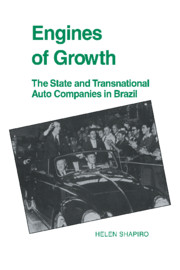Book contents
- Frontmatter
- Contents
- Tables and Figures
- Acknowledgments
- 1 Approaches to State Intervention
- 2 Why Auto?
- 3 The Determinants of Firm Entry
- 4 Rent Redistribution and Linkage Effects
- 5 The Automotive Parts Sector
- 6 Conclusion
- Appendix A Data Exhibits on the Brazilian Auto Industry
- Appendix B José Almeida's Calculation of Subsidies Provided to the Brazilian Automotive Industry
- Index
3 - The Determinants of Firm Entry
Published online by Cambridge University Press: 11 September 2009
- Frontmatter
- Contents
- Tables and Figures
- Acknowledgments
- 1 Approaches to State Intervention
- 2 Why Auto?
- 3 The Determinants of Firm Entry
- 4 Rent Redistribution and Linkage Effects
- 5 The Automotive Parts Sector
- 6 Conclusion
- Appendix A Data Exhibits on the Brazilian Auto Industry
- Appendix B José Almeida's Calculation of Subsidies Provided to the Brazilian Automotive Industry
- Index
Summary
Brazil's first attempts to convince transnational auto firms to shift from assembly to full manufacture were met with resistance. In the early 1950s, representatives of the Ford Motor Company told Brazilian planners that the idea of building a domestic automobile industry was “utopian” and that engines could not be produced in the tropics. These protests notwithstanding, Ford, accompanied by most of the major players in the international automotive industry, participated in Brazil's five-year auto program. Of the eleven firms that initiated vehicle production, three (WillysOverland, Vemag, and the National Motor Factory) were controlled by Brazilian capital, two (Mercedes- Benz and Simca) were fifty–fifty joint ventures between Brazilian and foreign capital, and six—Ford, General Motors (GM), International Harvester, Scania Vabis, Volkswagen (VW), and Toyota – were controlled by or were wholly owned subsidiaries of foreign firms. US$156 million of imported manufacturing equipment was invested in the terminal sector of the industry by 1961, not to mention investment in local currency. In that year, vehicle production reached 145,000 units, with an average domestic-content share of 93 percent by weight and 87 percent by value. By 1968, the industry had consolidated, and three foreign firms – Ford, GM, and VW – were responsible for 89 percent of all vehicles produced. Subsequently, the industry led the Brazilian economic “miracle” with annual growth rates of over 20 percent.
- Type
- Chapter
- Information
- Engines of GrowthThe State and Transnational Auto Companies in Brazil, pp. 70 - 133Publisher: Cambridge University PressPrint publication year: 1994



